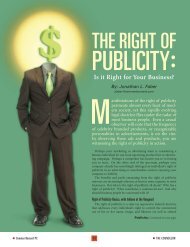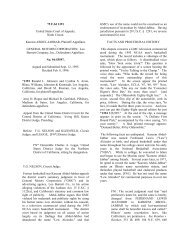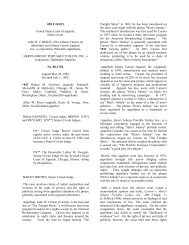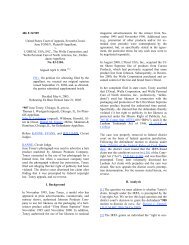Rufo v. OJ Simpson - Right Of Publicity
Rufo v. OJ Simpson - Right Of Publicity
Rufo v. OJ Simpson - Right Of Publicity
Create successful ePaper yourself
Turn your PDF publications into a flip-book with our unique Google optimized e-Paper software.
Page 47<br />
likeness in the future; <strong>Simpson</strong>'s expert accounting witness Goodfriend<br />
did not<br />
contradict this in principle. Plaintiffs' other witness Roesler<br />
testified the<br />
PAGE 35<br />
86 Cal. App. 4th 573, *621; 2001 Cal. App. LEXIS 41, **96;<br />
103 Cal. Rptr. 2d 492, ***525; 2001 Cal. Daily Op. Service 759<br />
right to exploit <strong>Simpson</strong>'s name and likeness had a present market<br />
value, for<br />
which a person in Roesler's business would pay. Therefore, even [**97]<br />
based on<br />
<strong>Simpson</strong>'s argument that present net worth is the [***526] only<br />
permissible<br />
measure of wealth, the evidence supported including this item as a<br />
component of<br />
present net worth.<br />
Furthermore, although net worth is the most common measure of wealth<br />
used in<br />
assessing punitive damages, it is not the exclusive measure. ( Adams v.<br />
Murakami, supra, 54 Cal. 3d at p. 116, fn. 7 [declining to adopt any<br />
rigid<br />
formula, such as net worth, to measure the defendant's ability to pay];<br />
Lara v.<br />
Cadag (1993) 13 Cal. App. 4th 1061, 1064-1065 & fns. 2, 3 [defining<br />
financial<br />
condition, concluding that earnings alone is not sufficient evidence of<br />
financial condition]; Kenly v. Ukegawa (1993) 16 Cal. App. 4th 49, 57 &<br />
fns. 6,<br />
7 [some evidence regarding liabilities must be offered, the defendant's<br />
profit<br />
on the fraudulent transaction, alone, is not sufficient evidence of<br />
financial<br />
condition]; Robert L. Cloud & Associates, Inc. v. Mikesell (1999) 69<br />
Cal. App.<br />
4th 1141, 1152 [income standing alone or wrongful profit standing alone<br />
are not<br />
sufficient evidence, there must be "meaningful evidence" "of the<br />
defendant's<br />
ability to pay the damage [**98] award"].) In Adams, supra, 54 Cal. 3d<br />
105, the<br />
Supreme Court primarily used the more general terms "financial<br />
condition" or<br />
"ability to pay" instead of "net worth."<br />
<strong>Simpson</strong> cites cases for the proposition that the defendant's wealth<br />
should be<br />
measured as of the time of trial. These cases held only that an earlier<br />
time<br />
period should not be used. ( Marriott v. Williams (1908) 152 Cal. 705,<br />
710, 93<br />
P. 875 [proper to show defendant's wealth at the time of trial, not the<br />
time<br />
when defendant inflicted the injury]; Zhadan v. Downtown Los Angeles<br />
Motor







